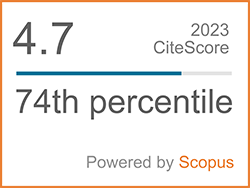Mechanical Characterization and Water Absorption Behavior of Waste Coconut Leaf Stalk Fiber Reinforced Hybrid Polymer Composite: Impact of Chemical Treatment
Abstract
Keywords
[1] M. K. Marichelvam, P. Manimaran, A. Verma, S. M. Rangappa, S. Siengchin, K. Kandakodeeswaran, and M. Geetha, “A novel palm sheath and sugarcane bagasse fiber-based hybrid composites for automotive applications: An experimental approach,” Polymer Composites, vol. 42, pp. 512– 521, Jan. 2021, doi: 10.1002/pc.25843.
[2] N. Jain, A. Verma, and V. K. Singh, “Dynamic mechanical analysis and creep-recovery behaviour of polyvinyl alcohol based cross-linked biocomposite reinforced with basalt fiber,” Materials Research Express, vol. 6, Sep. 2019, Art. no. 105373, doi: 10.1088/2053-1591/ ab4332.
[3] A. Verma, V. K. Singh, S. K. Verma, and A. Sharma, “Human hair: A biodegradable composite fiber–A review,” International Journal of Waste Resources, vol. 6, no. 206, p. 2, Apr. 2016, doi: 10.4172/2252-5211.1000206.
[4] K. N. Bharath, P. Madhu, T. G. Gowda, A. Verma, S. M. Rangappa, and S. Siengchin, “A novel approach for development of printed circuit board from biofiber based composites,” Polymer Composites, vol. 41, pp. 4550–4558, Nov. 2020, doi: 10.1002/pc.25732.
[5] A. Vinod, J. Tengsuthiwat, Y. Gowda, R. Vijay, S. M. Rangappa, S. Siengchin, and H. N. Dhakal, “Jute/Hemp bio-epoxy hybrid bio-composites: Influence of stacking sequence on adhesion of fiber-matrix,” International Journal of Adhesion and Adhesives, vol. 113, Mar. 2022, Art. no. 103050, doi: 10.1016/j.ijadhadh.2021.103050.
[6] Y. G. T. Girijappa, S. M. Rangappa, J. Parameswaranpillai, and S. Siengchin, “Natural fibers as sustainable and renewable resource for development of eco-friendly composites: A comprehensive review,” Frontier in Materials, vol. 6, Sep. 2019, Art. no. 226, doi: 10.3389/ fmats.2019.00226.
[7] K. N. Bharath, P. Madhu, Y. G. T. Girijappa, S. M. Rangappa, V. Kushvaha, and S. Siengchin, “Alkaline effect on characterization of discarded waste of Moringa oleifera fiber as a potential eco-friendly reinforcement for biocomposites,” Journal of Polymers and the Environment, vol. 28, pp. 2823–2836, Jul. 2020, doi: 10.1007/s10924- 020-01818-4.
[8] A. K. Bledzki, A. A. Mamun, and O. Faruk, “Abaca fibre reinforced PP composites and comparison with jute and flax fibre PP composites,” Express Polymer Letters, vol. 4, no. 11, pp. 455– 462, Oct. 2010, doi : 10.3144/expresspolymlett. 2007.104.
[9] A. K. Mohanty, M. Misra, and L. T. Drzal, “Surface modifications of natural fibers and performance of the resulting biocomposites: An overview” Composite Interfaces, vol. 8, no. 5, pp. 313–343, Jan. 2001, doi : 10.1163/1568554017 53255422
[10] A. Verma, C. Singh, V. K. Singh, and N. Jain, “Fabrication and characterization of chitosan-coated sisal fiber–Phytagel modified soy protein-based green composite,” Journal of Composite Materials, vol. 53, pp. 2481–2504, Feb. 2019, doi: 10.1177/0021998319831748.
[11] K. N. Bharath, P. Madhu, T. Y. Gowda, S. M. Rangappa, A. Verma, and S. Siengchin, “Mech anical and chemical properties evaluation of sheep wool fiber–reinforced vinylester and polyester composites,” Materials Performance and Characterization, vol. 10, pp. 99–109, Mar. 2021, doi: 10.1520/MPC20200036.
[12] A. Verma, A. Parashar, N. Jain, V. K. Singh, S. M. Rangappa, and S. Siengchin, “Surface modification techniques for the preparation of different novel biofibers for composites,” in Biofibers and Biopolymers for Biocomposites. Cham: Springer International Publishing, 2020, pp. 1–34. doi: 10.1007/978-3-030-40301-0_1.
[13] G. R. Arpitha, A. Verma, S. M. Rangappa, and S. Siengchin, “Preparation and experimental investigation on mechanical and tribological performance of hemp-glass fiber reinforced laminated composites for lightweight applications,” Advances in Civil Engineering Materials, vol. 10, pp. 427–439, Nov. 2021, doi: 10.1520/ ACEM20200187.
[14] G. R. Arpitha, N. Jain, and A. Verma, “Banana biofiber and glass fiber reinforced hybrid composite for lightweight structural applications: Mechanical, thermal, and microstructural characterization,” Biomass Conversion and Biorefinery, May 2023, doi: 10.1007/s13399- 023-04300-y.
[15] M. M. Shariff, G. R. Arpitha, N. Jain, U. Shankar, A. Verma, and N. D. Shivakumar, “A comparative study on the effect of reinforcing boron nitride/ alumina in epoxy-based hybrid composite with Millettia pinnata leaf powder and glass sheets: Experimental fabrication, mechanical and micro-structural characterization,” Hybrid Advances, vol. 4, Dec. 2023, Art. no. 100095, doi: 10.1016/j. hybadv.2023.100095.
[16] D. R. Mulinari, C. A. R. P. Baptista, J. V. C. Souza, and H. J. C. Voorwald, “Mechanical properties of coconut fibers reinforced polyester composites,” Procedia Engineering, vol. 10, pp. 2074–2079, Jun. 2011, doi: 10.1016/j.proeng. 2011.04.343.
[17] A. Verma, N. Jain, Kalpana, S. M. Rangappa, S. Siengchin, and M. Jawaid, “Natural fibers based bio-phenolic composites,” in Phenolic Polymers Based Composite Materials. Singapore: Springer, pp. 153–168, 2021, doi: 10.1007/978- 981-15-8932-4_10.
[18] A. Verma, N. Jain, and R. R. Mishra, “Applications and drawbacks of epoxy/natural fiber composites,” in Handbook of Epoxy/Fiber Composites. Singapore: Springer, pp. 1–15, 2022, doi: 10.1007/978-981-15-8141-0_32-1.
[19] G. Huang, “Tensile behaviours of the coir fibre and related composites after NaOH treatment,” Materials and Design, vol. 30 pp. 3931–3934, Oct. 2009, doi: 10.1016/j.matdes.2009.01.035.
[20] S. Harish, D. P. Michael, A. Bensely, D. M. Lal, and A. Rajadurai, “Mechanical property evaluation of natural fiber coir composite,” Materials Characterization, vol. 60, pp. 44–49, Jan. 2009, doi: 10.1016/j.matchar.2008.07.001.
[21] R. Rahman, M. Hasan, M. Huque, and N. Islam, “Physico-mechanical properties of maleic acid post treated jute fiber reinforced polypropylene composites,” Journal of Thermoplastic Composite Materials, vol. 22, p. 365, Jun. 2009, doi: 10.1177/0892705709100664.
[22] J. B. Zhong, J. Lv, and C. Wei, “Mechanical properties of sisal fibre reinforced urea-formaldehyde resin composites,” Express Polymer Letters, vol. 1, pp. 681–687, Aug. 2017, doi: 10.3144/ expresspolymlett.2007.93.
[23] J. Y. Jang, T. K. Jeong, H. J. Oh, J. R. Youn, and Y. S. Song, “Thermal stability and flammability of coconut fiber reinforced poly(lactic acid) composites,” Composites Part B: Engineering, vol. 43, pp. 2434–2438, Jul. 2012, doi: 10.1016/j. compositesb.2011.11.003.
[24] M. Brahmakumar, C. Pavithran, and R. M. Pillai, “Coconut fibre reinforced polyethylene composites: Effect of natural waxy surface layer of the fibre on fibre/matrix interfacial bonding and strength of composites,” Composites Science and Technology, vol. 65, pp. 563–569, Aug. 2005, doi: 10.1016/j.compscitech.2004.09.020.
[25] Y. G. T. Girijappa, S. B. Nagaraju, M. Puttegowda, A. Verma, S. M. Rangappa, and S. Siengchin, “Biopolymer-based composites: An eco-friendly alternative from agricultural waste biomass,” Journal of Composites Science, vol. 7, no. 6, p. 242, Jun. 2023, doi: 10.3390/jcs7060242.
[26] S. Chaturvedi, A. Kataria, V. Chaudhary, A. Verma, N. Jain, S. M. Rangappa, and S. Siengchin, “Bionanocomposites reinforced with cellulose fibers and agro-industrial wastes,” in Cellulose Fibre Reinforced Composites, Amsterdam: Netherlands: Elsevier, pp. 317–342, 2023, doi: 10.1016/B978-0-323-90125-3.00017-3.
[27] A. Verma, K. Baurai, S. M. Rangappa, and S. Siengchin, “Mechanical, microstructural, and thermal characterization insights of pyrolyzed carbon black from waste tires reinforced epoxy nanocomposites for coating application,” Polymer Composites, vol. 41, pp. 338–349, Jan. 2020, doi: 10.1002/pc.25373.
[28] A. Verma, A. Parashar, and M. Packirisamy, “Atomistic modeling of graphene/hexagonal boron nitride polymer nanocomposites: A review,” Wiley Interdisciplinary Reviews: Computational Molecular Science, vol. 8, p. 1346, May 2018, doi: 10.1002/wcms.1346.
[29] A. Verma, P. Negi, and V. K. Singh, “Experimental analysis on carbon residuum transformed epoxy resin: Chicken feather fiber hybrid composite,” Polymer Composites, vol. 40, pp. 2690–2699, Jul. 2019, doi: 10.1002/pc.25067.
[30] A. Verma, L. Budiyal, S. M. Rangappa, and S. Siengchin, “Processing and characterization analysis of pyrolyzed oil rubber (from waste tires)-epoxy polymer blend composite for lightweight structures and coatings applications,” Polymer Engineering & Science, vol. 59, pp. 2041–2051, Oct. 2019, doi: 10.1002/pen.25204.
[31] A. Verma and V. K. Singh, “Mechanical, microstructural and thermal characterization of epoxy-based human hair–reinforced composites,” Journal of Testing and Evaluation, vol. 47, pp. 1193–1215, Nov. 2017, doi: 10.1520/JTE 20170063.
[32] A. Verma, A. Gaur, and V. K. Singh, “Mechanical properties and microstructure of starch and sisal fiber biocomposite modified with epoxy resin,” Materials Performance and Characterization, vol. 6, pp. 500–520, Dec. 2017, doi: 10.1520/ MPC20170069.
[33] A. Verma, P. Negi, and V. K. Singh, “Physical and thermal characterization of chicken feather fiber and crumb rubber reformed epoxy resin hybrid composite,” Advances in Civil Engineering Materials, vol. 7, pp. 538–557, Aug. 2018, doi: 10.1520/ACEM20180027.
[34] A. Verma, P. Negi, and V. K. Singh, “Experimental investigation of chicken feather fiber and crumb rubber reformed epoxy resin hybrid composite: mechanical and microstructural characterization,” Journal of the Mechanical Behavior of Materials, vol. 27, Aug. 2018, Art. no. 20180014, doi: 10.1515/ jmbm-2018-0014.
[35] S. Rastogi, V. K. Singh, and A. Verma, “Experimental response of nonwoven waste cellulose fabric–reinforced epoxy composites for high toughness and coating applications,” Materials Performance and Characterization, vol. 9, pp. 151–172, Apr. 2020, doi: 10.1520/ MPC20190251.
[36] A. Verma, K. Joshi, A. Gaur, and V. K. Singh, “Starch-jute fiber hybrid biocomposite modified with an epoxy resin coating: Fabrication and experimental characterization,” Journal of the Mechanical Behavior of Materials, vol. 27, no. 5–6, Dec. 2018, doi: 10.1515/jmbm-2018- 2006.
[37] V. Dogra, C. Kishore, A. Verma, A. K. Rana, and A. Gaur, “Fabrication and experimental testing of hybrid composite material having biodegradable bagasse fiber in a modified epoxy resin: Evaluation of mechanical and morphological behavior,” Applied Science and Engineering Progress, vol. 14, pp. 661–667, Oct. 2021, doi: 10.14416/j.asep.2021.06.002.
[38] G. R. Arpitha, N. Jain, A. Verma, and M. Madhusudhan, “Corncob bio-waste and boron nitride particles reinforced epoxy-based composites for lightweight applications: Fabrication and characterization,” Biomass Conversion and Biorefinery, Dec. 2022, doi: 10.1007/s13399-022-03717-1.
[39] G. R. Arpitha, H. Mohit, P. Madhu, and A. Verma, “Effect of sugarcane bagasse and alumina reinforcements on physical, mechanical, and thermal characteristics of epoxy composites using artificial neural networks and response surface methodology,” Biomass Conversion and Biorefinery, Feb. 2023, doi: 10.1007/s13399- 023-03886-7.
[40] M. K. Lila, A. Verma, and S. S. Bhurat, “Impact behaviors of epoxy/synthetic fiber composites,” in Handbook of Epoxy/Fiber Composites. Singapore: Springer, pp. 1–18, 2022, doi: 10.1007/978-981-15-8141-0_55-1.
[41] S. Sharma, A. Verma, S. M. Rangappa, S. Siengchin, and S. Ogata, “Recent progressive developments in conductive-fillers based polymer nanocomposites (CFPNC’s) and conducting polymeric nanocomposites (CPNC’s) for multifaceted sensing applications,” Journal of Materials Research and Technology, vol. 26, pp. 5921–5974, Oct. 2023, doi: 10.1016/j.jmrt. 2023.08.300.
[42] A. Verma, N. Jain, and S. K. Sethi, “Modeling and simulation of graphene-based composites,” in Innovations in Graphene-Based Polymer Composites. Amsterdam: Netherlands: Elsevier, pp. 167–198, 2022, doi: 10.1016/B978-0-12- 823789-2.00001-7.
[43] E. S. Rodriguez, P. M. Stefani, and A. Vazquez, “Effects of fibers' alkali treatment on the resin transfer molding processing and mechanical properties of Jute-Vinylester composites,” Journal of Composite Materials, vol. 41, pp. 1729–1741, Jul. 2007, doi: 10.1177/0021998306069889.
[44] C. Girisha, Sanjeevamurthy, and G. R. Srinivas, “Sisal/coconut coir natural fibers –epoxy composites: Water absorption and mechanical properties,” International Journal of Engineering and Innovative Technology (IJEIT), vol. 2, no. 3, Sep. 2012.
DOI: 10.14416/j.asep.2024.05.003
Refbacks
- There are currently no refbacks.









